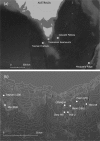A comparison of genetic connectivity in two deep sea corals to examine whether seamounts are isolated islands or stepping stones for dispersal
- PMID: 28393887
- PMCID: PMC5385499
- DOI: 10.1038/srep46103
A comparison of genetic connectivity in two deep sea corals to examine whether seamounts are isolated islands or stepping stones for dispersal
Abstract
Ecological processes in the deep sea are poorly understood due to the logistical constraints of sampling thousands of metres below the ocean's surface and remote from most land masses. Under such circumstances, genetic data provides unparalleled insight into biological and ecological relationships. We use microsatellite DNA to compare the population structure, reproductive mode and dispersal capacity in two deep sea corals from seamounts in the Southern Ocean. The solitary coral Desmophyllum dianthus has widespread dispersal consistent with its global distribution and resilience to disturbance. In contrast, for the matrix-forming colonial coral Solenosmilia variabilis asexual reproduction is important and the dispersal of sexually produced larvae is negligible, resulting in isolated populations. Interestingly, despite the recognised impacts of fishing on seamount communities, genetic diversity on fished and unfished seamounts was similar for both species, suggesting that evolutionary resilience remains despite reductions in biomass. Our results provide empirical evidence that a group of seamounts can function either as isolated islands or stepping stones for dispersal for different taxa. Furthermore different strategies will be required to protect the two sympatric corals and consequently the recently declared marine reserves in this region may function as a network for D. dianthus, but not for S. variabilis.
Conflict of interest statement
The authors declare no competing financial interests.
Figures






Similar articles
-
Out of their depth? Isolated deep populations of the cosmopolitan coral Desmophyllum dianthus may be highly vulnerable to environmental change.PLoS One. 2011;6(5):e19004. doi: 10.1371/journal.pone.0019004. Epub 2011 May 18. PLoS One. 2011. PMID: 21611159 Free PMC article.
-
Exploring the role of Micronesian islands in the maintenance of coral genetic diversity in the Pacific Ocean.Mol Ecol. 2015 Jan;24(1):70-82. doi: 10.1111/mec.13005. Epub 2014 Dec 13. Mol Ecol. 2015. PMID: 25407355
-
Diversity of zoanthids (anthozoa: hexacorallia) on Hawaiian seamounts: description of the Hawaiian gold coral and additional zoanthids.PLoS One. 2013;8(1):e52607. doi: 10.1371/journal.pone.0052607. Epub 2013 Jan 9. PLoS One. 2013. PMID: 23326345 Free PMC article.
-
The Biology of Seamounts: 25 Years on.Adv Mar Biol. 2018;79:137-224. doi: 10.1016/bs.amb.2018.06.001. Epub 2018 Jul 6. Adv Mar Biol. 2018. PMID: 30012275 Review.
-
Larval dispersal and movement patterns of coral reef fishes, and implications for marine reserve network design.Biol Rev Camb Philos Soc. 2015 Nov;90(4):1215-47. doi: 10.1111/brv.12155. Epub 2014 Nov 25. Biol Rev Camb Philos Soc. 2015. PMID: 25423947 Review.
Cited by
-
Population genetic structure and connectivity of deep-sea stony corals (Order Scleractinia) in the New Zealand region: Implications for the conservation and management of vulnerable marine ecosystems.Evol Appl. 2017 Jul 20;10(10):1040-1054. doi: 10.1111/eva.12509. eCollection 2017 Dec. Evol Appl. 2017. PMID: 29151859 Free PMC article.
-
Distribution of deep-water scleractinian and stylasterid corals across abiotic environmental gradients on three seamounts in the Anegada Passage.PeerJ. 2020 Jul 31;8:e9523. doi: 10.7717/peerj.9523. eCollection 2020. PeerJ. 2020. PMID: 32821533 Free PMC article.
-
Merging scleractinian genera: the overwhelming genetic similarity between solitary Desmophyllum and colonial Lophelia.BMC Evol Biol. 2016 May 18;16(1):108. doi: 10.1186/s12862-016-0654-8. BMC Evol Biol. 2016. PMID: 27193263 Free PMC article.
-
Connectivity and Adaptation Patterns of the Deep-Sea Ground-Forming Sponge Geodia hentscheli Across Its Entire Distribution.Mol Biol Evol. 2025 Jul 1;42(7):msaf145. doi: 10.1093/molbev/msaf145. Mol Biol Evol. 2025. PMID: 40476758 Free PMC article.
-
High Connectivity at Abyssal Depths: Genomic and Proteomic Insights Into Population Structure of the Pan-Atlantic Deep-Sea Bivalve Ledella ultima (E. A. Smith, 1885).Ecol Evol. 2025 Aug 8;15(8):e71903. doi: 10.1002/ece3.71903. eCollection 2025 Aug. Ecol Evol. 2025. PMID: 40785988 Free PMC article.
References
-
- Van Dover C. L. et al.. Designating networks of chemosynthetic ecosystem reserves in the deep sea. Marine Policy 36, 378–381 (2012).
-
- Danavaro R., Snelgrove P. V. R. & Tyler P. Challenging the paradigms of deep-sea ecology. Trends in Ecology & Evolution 29, 464–475 (2014). - PubMed
-
- Clark M. R. & Koslow J. A. Impacts of fisheries on seamounts. (Blackwell, 2007).
-
- Williams A. et al.. Seamount megabenthic assemblages fail to recover from trawling impacts. Marine Ecology 31, 183–199 (2010).
Publication types
MeSH terms
LinkOut - more resources
Full Text Sources
Other Literature Sources

